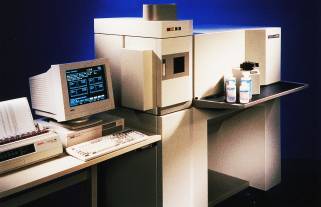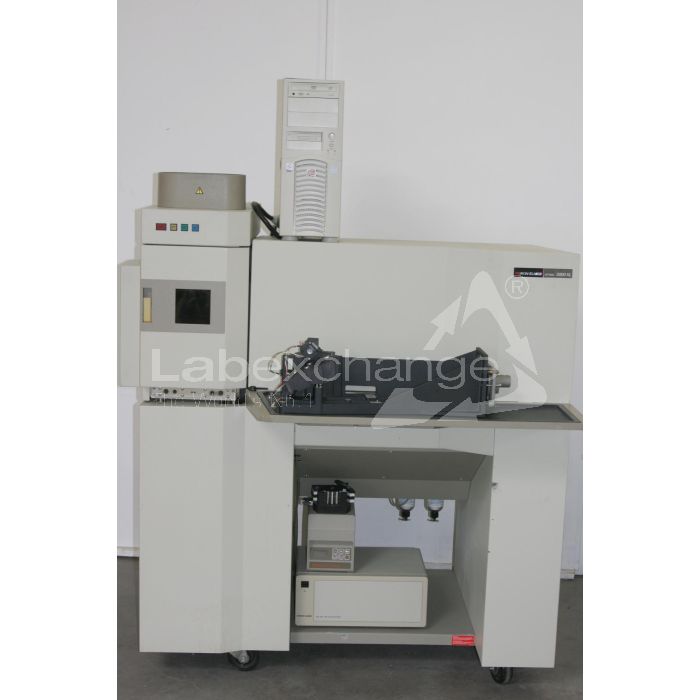Perkin Elmer Optima 3000 XL
| Objektnummer | B00024445 |
|---|---|
| Numéro d'identification | 024445 |
| Nom de l'objet | Perkin Elmer Optima 3000 XL |
| Statut | Stock unit |
Groupe de produits: Systèmes ICP
Statut, conditions de livraison et de paiement
Vérification des appareils
Les appareils d’occasion sont vérifiés par Labexchange Service GmbH avant la livraison. Vous recevez des appareils entièrement fonctionnels.
Délai d'expédition
Les délais de livraison indiqués sont les plus rapides pour l’article en cause. Les délais de fait peuvent varier au cas par cas. Les délais de livraison définitifs sont indiqués dans la confirmation de commande.
Nous offrons des livraisons collectives par principe. Le délai de livraison s’oriente à l’article avec le délai de livraison le plus long. Une livraison partielle est possible par prix additionnel.
Méthodes d'expédition
Courrier, agences d'expédition, autocueillette, livraison par flotte de Labexchange
Conditions de livraison
Prix plus frais d’expédition. Les frais d’expédition indiqués sont à prévoir. Dérogations éventuelles sont possibles.
Si les coûts de transport ne sont pas spécifiés, s'il vous plaît demander séparément les frais de transport. Les frais de transport et d'emballage indiqués se réfèrent à l'itinéraire de transport le moins cher et sont sujets à des augmentations de coûts imprévues. En raison d'événements imprévisibles, les tarifs de transport et les délais de livraison peuvent changer à tout moment et doivent être adaptés à la situation actuelle. Incoterm codage selon les Incoterms 2010: Pour personnes qui viennent chercher les dispositifs elles-mêmes: EXW, pour les expéditions par voie maritime: CFR, par avion: CPT, d'autres expéditions: DAP. Remarque: Nous n'établissons pas des preuves préférentielles/EUR1. Dans le cas d’un enlèvement par vos soins/EXW de pays à l’intérieur ou à l’extérieur de la Union européenne, nous devons conserver 16% de TVA d’acheteur comme dépôt de garantie, jusqu’à ce que nous ayons reçu l’attestation de reception/la prevue de livraison.
Modalités de paiement
Nous n’acceptons pas le paiement par lettre de credit, PayPal, etc. Dans tous les cas le montant est payable sans déduction. Jusqu’au paiement complèt l’équipement reste notre propriété. Un escompte n’est pas accordé.
|
Pays |
Modalités de paiement possible |
Remarque |
|
DE, AT, CH |
Paiement par facture, prépaiement, par carte de credit |
Paiement par facture est possible pour clients professionnels. |
|
NL, BE, LU |
Paiement par facture, prépaiement, par carte de credit |
Paiement par facture est possible pour clients professionnels. |
|
Autre pays |
Prépaiement, par carte de credit |
|
Nos conditions de vente, de livraison et de paiement sont en vigueur. Vous pouvez télécharger les documents ici.
La vente intermédiaire nous est réservée.
Défintion des statuts
Tous articles sont d’occasion, sauf si explicitement défini comme « appareil neuf ».
|
Statut |
Condition |
Remarque |
|
Immédiatement disponible |
Occasion |
L’article a été déjà entièrement vérifié et peut être envoyé directement à vous. |
| En stock |
Occasion |
L'article est en notre stock, mais doit être vérifié avant la livraison par nos techniciens Vous recevez des articles entièrement fonctionnels. |
|
Publié |
Occasion |
L’article est toujours au l’offreur. Nous achetons, vérifions et en fin livrons l’article après votre commande. Le certificat de fonctionnement ainsi que le rapport de service sont inclus à la livraison. |
|
Appareil neuf |
Neuf |
C’est un dispositif neuf. L’article n’est pas utilisé et neuf d’usine. En ce qui concerne des article neufs, la garantie du fabricant est valable. |
|
Labprocure |
Occasion |
Responsable du contenu de l‘offre d’appareil est la société Labprocure GmbH, comme annonceur. Labprocure assume la responsabilité des offres annoncées ici ainsi que des photos et des textes d’offre inclus. Labprocure GmbH, Bruckstraße 58, 72393 Burladingen. |
Firma: Perkin Elmer
Nachfolgende Abbildungen und Beschreibungen sind modellbezogen und aus Prospekten entnommen.
Sie geben nicht den Lieferumfang des Systems wieder.
Den exakten Lieferumfang entnehmen Sie bitte aus dem Angebotstext.

Optima 3000XL ICP-Emissionsspektrometer
Vollautomatisch arbeitendes Emissionsspektrometer für die simultane Multielementanalyse von Lösungen mit ICP-Anregung. Für höhere Nachweisstärken wird ein axiales Plasma genutzt. Das System besteht aus einem Spektrometer einschließlich Polychromator, Probeneinführungssystem, HF-Generator, Steuerrechner mit Farbbildschirm und Drucker.
Optik
Der von Perkin-Eimer entwickelte optische Aufbau nutzt ein Gitter, das für den UV-Bereich optimiert wurde. Dieses Gitter weist 79 Linien/mm mit einem Blaze-Winkel von 63° auf. Um eine möglichst getreue Abbildung zu erzielen, wird das gestreute Licht in zwei Bereiche unterteilt-. Der sichtbare Bereich wird mit einem Prisma weiter unterteilt, während der UV-Bereich von einem Schmidt Cross Disperser zerlegt wird.
Der Schmidt Cross Disperser hat drei Aufgaben: (1) Durch ihn wird das Licht in UV- und VIS-Bereich unterteilt. Dies erfolgt mit einem Loch in der Mitte: das Licht in der Mitte gelangt ungehindert zum Prisma während (2) der UV-Bereich vom mit Linien versehenen Randbereich weiter dispergiert wird. (3) Eine weitere Aufgabe besteht darin, die spährische Aberation der Kamera-Ebene zu korrigieren. Diese Konstruktion bewirkt eine hohe Lichtausbeute und eine hervorragende Auflösung.
Der einzigartige optische Aufbau hat folgende Vorteile:
Die simultane Messung der analytischen Linie und des Untergrundes führt zu verbesserter Präzision und höherem Analysendurchsatz. Eine Auflösung von < 7 pm im unteren UV-Bereich. Eine sehr hohe UV-Quantenausbeute führt zu verbesserten Nachweisgrenzen. Ein hoher dynamischer Bereich umfaßt Konzentrationen von ppb bis %. Random access readout bedeutet: alle Subarrays können einzeln gelesen werden, um ein Maximum an Flexibilität zu erzielen. Die Detektoren werden auf -40°C gekühlt, was zu einem sehr niedrigen Dunkelstrom führt. Die Isolierung und Thermostatisierung der Optik bei 38°C führt zu einer hervorragenden Wellenlängenstabilität.
Probeneinführungssystem
Das Probeneinführungssystem ist leicht zugänglich: Zwei Türen, eine vorn, eine an der Seite, ermöglichen einen guten Zugang zum Probeneinführungssystem, das als Schnellwechseleinheit eingesetzt ist. Die Vordertürenthältein FensterzurBeobachtung des Plasmas. Sicherungseinrichtungen überwachen das querliegende Plasma.
Das Probeneinführungssystem besteht aus einerzerlegbaren Fackel (das äußere und mittlere Rohr sind fest miteinander verbunden, um ein stabiles Plasma zu gewährleisten), einem Aluminiumoxid-Injektor, einer RytonSprühkammer (beständig gegen alle gebräuchlichen Aufschlußsäuren einschl. Flußsäure und Königswasser sowie organische Lösungsmittel).
Die zerlegbare Fackel enthält standardmäßig einen Aluminiumoxid-Injektor mit 2 mm Innendurchmesser. Verschiedene Innendurchmesser sind aus Aluminiumoxid und Quarz verfügbar. Der Abstand des Injektors kann relativ zur HF-Spule justiert werden.
Ein Cross-Flow-Zerstäuber mit Ryton-Endkappe und Aluminiumoxid-Düseneinsätzen wird als Standard-Zerstäuber eingesetzt. Weitere Typen (Meinhard, Sharp-Cone-Spray, van-der-Plas, Ultraschall) sind als Option erhältlich. Das Zerstäuber-Gas wird durch einen software-gesteuerten Mass-Flow-Controller reguliert.
Eine Computer-gesteuerte Drei-Kanal-Hochpräzisions-Schlauchpumpe dient der Probenzuführung und dem Abpumpen des Ablaufs (der dritte Kanal kann für Sonderanwendungen genutzt werden).
Hochfrequenz-Generator
Ein freilaufender 40-MHz-Generator dient zur Leistungseinkoppelung in das Plasma. Ein freilaufender Generator reagiert trägheitslos auf Laständerungen im Plasma durch Frequenzverschiebung. Die Leistung kann mittels Software im Bereich zwischen 750 und -1500 VV in Intervallen von 5 VV eingestellt werden. Die Leistung wird in einem Regelkreis (True Power Control: TPC) geregelt.
Der HF-Generator nutzt eine luftgekühlte Keramik-Leistungsröhre, die elektronisch, thermisch und mechanisch stabil ist. Sie wurde konzipiert, um eine hohe Zuverlässigkeit, lange Lebensdauer und eine einfache
Wartung zu vereinen. Um die Lebensdauer zu erhöhen wird der Heizstrom (tube filament) abgeschaltet, wenn die Röhre nicht benutzt wird. Die HF-Abschirmung entspricht den FCC- und VDE-Richtlinien.
Computer und Drucker
Die Optima 3000-Software verwendet den DEC-Rechner 466d2LPv und den EPSON-Drucker LQ-870. Die Funktion der Software wird nur in dieser Konfiguration gewährleistet.
Personal Computersystem DECpc 466d2LPv mit ISA-Bus, 80486d2 32-Bit Prozessor, 66 MHz, 8 MB Speicher (max. 64 MB), 3S-805 Graphikprozessor mit 1 MB DRAM, 426 MB SCSI Festplatte, 525 MB SCSI Bandlaufwerk, 3571,44 MB Diskettenlaufwerk, 2 freie 16-Bit Steckplätze. Schnittstellen parallel und 2 seriell. Farbmonitor 17, Länderkit und Tastatur.
EPSON LQ-870-Matrixdrucker mit 24 Nadeln, 80 Zeichen/Zeile, bis 300 Zeichen/sec-, bis 90 Zeichen/sec in Schönschrift; Graphik mit 360 Punkten/ Zoll Auflösung, RS-232C- und Centronics-Parallel-Schnittstellen und Centronics-Anschlußkabel.
Software-Paket
Enthält Optima 3000 Software, UNIX-Betriebssystem für DEC-Rechner, Optima 3000 Handbücher, Overlay, IEEE-488 Kabel, 3,5"-Leerdisketten und Druckerpapier.
Die Optima 3000 Software ist multitaskingfähig. Sie ermöglicht ein Höchstmaß an Flexibilität und eine einfache Bedienung. Das Software-Konzept ermöglicht sowohl eine einfache Routineoperation wie auch eine ausgefeilte Methodenoptimierung. Einige Merkmale der Software sind-.
Standardbedingungen und -einstellungen-, globale Änderungen eines ausgewählten Datensatzes: Wellenlängenbibliothek mit 50.000 Einträgen; Speicherung und Darstellung von Spektren; hochauflösende Graphik; automatische Zentrierung des Analytkanals auf der optischen Achse des Spektrometers-, Piktogramme zur Zustandsanzeige des Spektrometers; Interelement-Korrektur und multiple interne Standards.
Weitere, hochentwickelte Software-Merkmale sind:
Auto-Integrationszeit-Bestimmung: Hiermit wird vor Beginn der Messung die Integrationszeit fürjedes einzelne Subarray dem emittierten Licht in diesem Wellenlängenbereich angepaßt, so daß eine optimale Zählstatistik resultiert. Die automatische dynamische Untergrundkorrektur legt die Untergrundkorrekturpunkte anhand der spektralen Störungen bei jeder einzelnen Wiederholung und jedem Subarray individual fest. Neuberechnung einerAnalyse mit geänderten Parametern (z.B. korrigierte manuell gesetzte Untergrundkorrekturpunkte oder Standardkonzentrationen) mit Hilfe von gespeicherten Spektren, ohne daß die Lösungen neu gemessen werden müssen. Die Optimierung mit Directed Search (gezielte Suche) unterstützt eine schnelle Methodenoptimierung. Multicomponent Spectral Fitting (MSF) dient zur mathematischen Filterung von spektralen Störungen. Quasi-Macro-Programmierung mit Hilfe von EXEC-Files dient der weitgehenden Automatisierung.
Kompressor (wahlweises Zubehör)
Zwei Kompressoren.
Probenautomat AS-91 (wahlweises Zubehör)
Computergesteuertes Probenaufgabesystem zur vollautomatischen, sequentiellen Multielementbestimmung mit spezieller Versorgungseinheit mit drei austauschbaren Probentabletts. Steuerung erfolgt über die Betriebssoftware des ICP Spektrometers. Auswechselbare Probentabletts mit 152 Probenpositionen für 15-mL-Probengefäße (im Lieferumfang enthalten) oder 218 Positionen für 6-mL-Gefäße oder 55 Positionen für 50-mL-Gefäße (Option) und eine Position für einen Waschbehälter, PTFEProbenkapillare mit 0,6-mm-Innendurchmesser.
Ultraschallzerstäuber CETAC U-5000AT (wahlweises Zubehör)
Zubehör zur ICP-AES und ICP-MS zur Steigerung der Empfindlichkeit und des Nachweisvermögens. Komplette Einheit, bestehend aus Ultraschallzerstäuber, Umlaufkühlung (benötigt 2.5 L Kühlmittel, z.B. Diethylenglycol) und Laborwagen.







